Explore null | Canon Latin America

EOS 60Da
- Increased IR Sensitivity ideal for astrophotography
- 18.0 Megapixel CMOS Imaging Sensor (APS-C size)
- Vari-angle 3.0-inch Clear View LCD monitor with approximately 1,040,000 dots
- Compatible with Canon's extensive family of EF and EF-S lenses and EOS accessories
- EOS 60Da Body
- Eyecup Eb (not shown)
- Wide Strap EW-100DBIII
- USB Interface Cable IFC-130U
- Remote Controller Adapter RA-E3
- AC Adapter Kit ACK-E6
- Stereo AV Cable AVC-DC400ST
- Battery Pack LP-E6
- Battery Charger LC-E6
- EOS Digital Solution Disc and Software Instruction Book CD
- Camera Instruction Book (not shown)
- Pocket Guide (not shown)
-
OVERVIEW
-
SPECIFICATIONS
-
ACCESSORIES
-
RESOURCES
-
SUPPORT
-
MISCELLANEOUS
Stellar Performer.


















To capture the full range of colors given off by diffuse nebulae in the sky, the EOS 60Da features a specially tailored infrared blocking filter that allows the light normally blocked by a typical DSLR's filter to be captured by the camera's sensor. This means that the reddish hydrogen-alpha (Hα) light (656nm) gasses unseen by a normal DSLR are captured brightly and clearly on the EOS 60Da. With its modified infrared blocking filter, the EOS 60Da captures approximately 3x the hydrogen-alpha (Hα) rays than the EOS 60D, resulting in astrophotography that is sharper, clearer and more accurate in the depiction of naturally occurring reddish hues of diffuse nebulae.
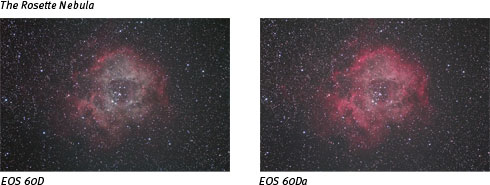
The EOS 60Da features an 18.0 Megapixel APS-C size CMOS sensor that captures such a high level of resolution it's easy to crop images for enlargement without concern of losing detail. A major factor in reducing noise, the CMOS sensor assures that images shot at highest sensitivity will be remarkably smooth even with the long exposures associated with astrophotography.
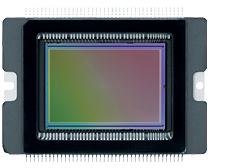
ISO 100–6400; expandable to ISO 12800 in H mode
With a broad range of ISO settings, expandable up to ISO 12800 with Custom Functions, the EOS 60Da can capture fine details with low noise, which is exceptionally ideal for the challenging conditions of astrophotography.
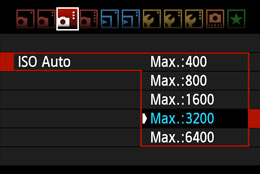
DIGIC 4 Image Processor
The DIGIC 4 Image Processor - the same found on the original EOS 60D - ensures that images are captured, processed and saved with remarkable speed. The EOS 60Da offers multiple aspect ratio shooting, in-camera RAW image processing, creative filters, image resizing and provides S2 and S3 image-recording quality thanks to the power of the DIGIC 4 Image Processor. With dazzling results, the DIGIC 4 Image Processor also works to capture and process data of images shot at 18.0 Megapixels at 5.3 fps, as well as 14-bit signal processing for excellent image gradation, no matter the exposure.

The EOS 60Da features a bright, high resolution, flip-out Vari-angle 3.0-inch Clear View LCD monitor for shooting at a variety of angles. Convenient in all situations, the monitor's flexibility lends itself to tripod-mounted shooting towards the sky, offering a comfortable alternative to through-the-lens composition.
With 1,040,000 dots for spectacular detail, the advanced, smudge-resistant monitor includes high transparency materials plus anti-reflective and water-repellant coatings to provide clear and bright viewing. Superb for reviewing, editing and deleting photos or composing new images in Live View function, the Vari-angle Clear View LCD monitor is also the perfect means for accessing camera settings like ISO, metering modes, AF Point selection, and the horizontal Electronic Level.
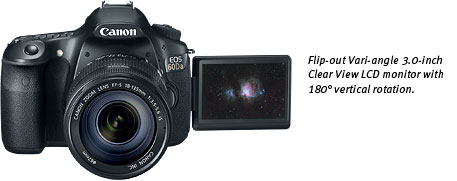
The EOS 60Da comes bundled with the new Remote Controller Adapter RA-E3 for total compatibility with Canon's remote switch for EOS cameras with the N3-type socket, the Timer Remote Controller TC-80N3. This remote switch has a self-timer, interval timer, long exposure timer and exposure-count setting feature. The timer can be set from 1 second to 99 hours. A dial enables numerous settings to be accessed one-handed. It has an illuminated LCD panel and a 2.6ft/80cm cord. Perfect for nighttime setups, and for shooting at the sky, the Timer Remote Controller TC-80N3 is the perfect complement to the EOS 60Da's power.
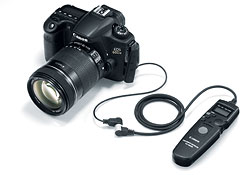
The EOS 60Da is compatible with all Canon lenses in the EF and EF-S lineup, ranging from ultra-wide angle to super telephoto lenses. Canon lenses employ advanced optical expertise and micron-precision engineering to deliver unprecedented performance in all facets of the photographic process. Special optical technologies, such as aspherical, ultra-low dispersion, or fluorite elements are featured in the universally acclaimed L-series lenses. And Canon's Optical Image Stabilizer technology is featured in select lenses to minimize the effect of camera shake. Additionally, the lenses used for astrophotography are compatible with every other EOS SLR; Canon wide-angle, macro, super-telephoto, tilt-shift and fisheye lenses provide a wealth of focal lengths, depth-of-field and other creative shooting options.
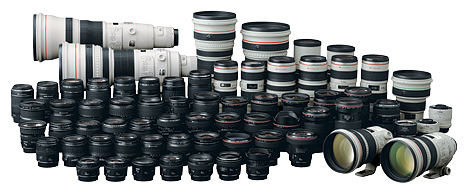
EOS Accessories.
Canon offers a host of accessories to help photographers make the most of the EOS 60Da's powerful features. For long exposures using Live View, the AC Adapter Kit ACK-E6 provides a constant source of AC power to the camera. For composing through the viewfinder, Angle Finder C enables an adjustable viewing angle while providing a 2.5x magnification for critical focusing with a full screen image that also shows exposure data. Battery Grip BG-E9 enables the use of AA batteries or two LP-E6 batteries and adds the convenience of access to all the cameras features in both portrait and landscape orientation.
| Type | Digital, AF/AE Single-Lens Reflex, Camera With Built-In Flash |
| Recording Medium | SD/SDHC/SDXC Memory Cards |
| Image Format | Approx. 0.88 X 0.59 In. / 22.3 X 14.9mm (APS-C Size) |
| Compatible Lenses | Canon EF And EF-S Lenses (35mm-Equivalent Focal Length Is Approx. 1.6x The Lens Focal Length) |
| Lens Mount | Canon EF Mount |
| Type | High-Sensitivity, High-Resolution, Large Single-Plate CMOS Sensor |
| Pixels | Effective: Approx. 18.0 Megapixels: 5200 (H) X 3462 (V) Pixels |
| Total Pixels | 19.0 Megapixels: 5432 (H) X 3492 (V) Pixels |
| Aspect Ratio | 3:2 (Horizontal: Vertical) |
| Color Filter System | RGB Primary Color Filters |
| Low Pass Filter | Fixed Position In Front Of The Image Sensor |
| Dust Deletion Feature | (1) Self Cleaning Sensor Unit · Removes Dust Adhering To Low-Pass Filter. · Self-Cleaning Executed Automatically (Taking About 2 Sec.) When Power Is Turned On Or Off. Manual Execution Also Possible (Taking About 6 Sec.). · Low-Pass Filter Has A Fluorine Coating. (2) Dust Delete Data Acquisition And Appending · The Coordinates Of The Dust Adhering To The Low-Pass Filter Are Detected By A Test Shot And Appended To Subsequent Images. · The Dust Coordinate Data Appended To The Image Is Used By The Provided Software To Automatically Erase The Dust Spots. (3) Manual Cleaning |
| Recording Format | Design Rule For Camera File System 2.0 And EXIF 2.3 |
| Image Format | Still Image: JPEG, RAW (14-Bit Canon Original), M-RAW, S-RAW, RAW+JPEG, M-RAW+JPEG, S-RAW+JPEG Video: MOV (Image Data: H.264; Audio: Linear PCM) |
| File Size | 1. Large/Fine: Approx. 17.90 Megapixels (5184 X 3456) 2. Medium/Fine: Approx. 8.00 Megapixels (3456 X 2304) 3. Small 1/Normal: Approx. 4.50 Megapixels (2592 X 1728) 4. Small 2/Fine: Approx. 2.50 Megapixels (1920 X 1280) 5. Small 3/Fine: Approx. 0.35 Megapixels (720 X 480) 6. RAW: Approx. 17.90 Megapixels (5184 X 3456) 7. M-RAW: Approx. 10.10 Megapixels (3888 X 2592) 8. S-RAW: Approx. 4.50 Megapixels (2592 X 1728) Exact File Sizes Depend On The Subject, ISO Speed, Picture Style, Etc. |
| Recording Functions | 1. Card Access Indicator (Access Lamp Blinking) 2. Read Error Warning (The Respective Error Warning Is Displayed In The Viewfinder And On The LCD Monitor, And The Shutter Release Locks 3. Card Formatting (Normal Formatting And Low-Level Formatting Are Possible 4. No Card Warning Provided |
| Backup Recording | N/A |
| File Numbering | The Following Three Types Of File Numbers Can Be Set: (1) Continuous Numbering * The Continuous Numbering Of Captured Images Will Continue Even After You Replace The Camera's Card. (The Numbering Continues Even When The Folder Changes.) (2) Auto Reset * When You Replace The Camera's Card, The Numbering Will Be Reset To Start From 0001. If The New Card Already Contains Images, The Numbering Will Continue From The Last Recorded Image In The Card. (3) Manual Reset * Resets The File Number To 0001, And Creates A New Folder Automatically. |
| Raw Jpeg Simultaneous Recording | The Image-Recording Quality Can Be Selected In Any Combination Of The Three RAW And Eight JPEG Recording Quality Settings. |
| Color Space | Selectable Between SRGB And Adobe RGB |
| Picture Style | Standard, Portrait, Landscape, Neutral, Faithful, Monochrome, User Defined 1-3 |
| Settings | Auto (AWB), Daylight, Shade, Cloudy, Tungsten Light, Fluorescent Light, Flash*, Custom (Custom WB), Color Temperature * Automatically Adjusted By The Built-In Flash And EX-Series Speedlite With Color Temperature Communication Feature. Set To Approx. 6000K If The Flash Unit Does Not Have The Color Temperature Communication Feature. |
| Auto White Balance | Auto White Balance With The Image Sensor |
| Color Temperature Compensation | · Blue/Amber Bias: ±9 Levels · Magenta/Green Bias: ±9 Levels * Correction Based On The Current WB Mode's Color Temperature. |
| Color Temperature Information Transmission | Provided |
| Type | Eye-Level Pentaprism |
| Coverage | Approx. 96% Vertically And Horizontally (At Approx. 22mm Eyepoint) |
| Magnification | Approx. 0.95x / 27.0° (With 50mm Lens At Infinity, -1 M-1 (Diopter)) |
| Eyepoint | Approx. 22mm (At -1m-1 From The Eyepiece Lens Center) |
| Dioptric Adjustment Correction | -3.0 To +1.0m-1 (Diopter) |
| Focusing Screen | Ef-A Provided As The Standard Focusing Screen (Interchangeable. Ef-D: Grid Lines, Ef-S: Point Of Focus) |
| Mirror | Quick-Return Half Mirror (Transmission: Reflectance Ratio Of 40:60) |
| Viewfinder Information | · AF Information AF Point, Focus Confirmation, AF Status Indicator · Exposure Information Shutter Speed, Aperture, ISO Speed (Always Displayed), AE Lock, Exposure Level, Exposure Warning · Flash Information Flash Ready, Flash Exposure Compensation, High-Speed Sync, FE Lock, Red-Eye Reduction Light · Image Information Highlight Tone Priority (D+), Maximum Burst (2-Digit Display), Card Information · Battery Check · Electronic Level (Horizontal Only) |
| Depth Of Field Preview | Enabled With Depth-Of-Field Preview Button |
| Type | TTL-CT-SIR AF-Dedicated CMOS Sensor |
| Af Points | All Nine AF Points Are Cross-Type (Center AF Point With Dual Cross Sensor For F/2.8) |
| Af Working Range | EV -0.5 To 18 (At 73°F/23°C And ISO 100) |
| Focusing Modes | (1) Autofocus · One-Shot AF · Predictive AI Servo AF · AI Focus AF (Switches Between One-Shot AF And AI SERVO AF Automatically) (2) Manual Focus (MF) |
| Af Point Selection | (1) Automatic Selection * With C.Fn III -2 To 1, The Multi-Controller Can Be Used To Select The AF Point Directly. (2) Manual Selection * Set Automatically In Basic Zone Modes. |
| Selected Af Point Display | Indicated By Superimposed Display In The Viewfinder And On The LCD Panel |
| Af Assist Beam | Intermittent Firing Of Built-In Flash: Effective Range: Approx. 13.1 Ft./4m At Center, Approx. 11.5 Ft./3.5m At Periphery. * With An EOS-Dedicated Speedlite Attached, The Speedlite's AF-Assist Beam Is Emitted Instead. |
| Metering Modes | Max. Aperture TTL Metering With 63-Zone SPC With The Following Selectable Modes: (1) Evaluative Metering (Linked To All AF Points) (2) Partial Metering (Center, Approx. 6.5% Of Viewfinder) (3) Spot Metering (Center, Approx. 2.8% Of Viewfinder) (4) Center-Weighted Average Metering |
| Metering Range | EV 0 To 20 (At 73°F / 23°C With 50mm F/1.4 Lens At ISO 100) |
| Exposure Control Systems | (1) Program AE (Shiftable) (2) Shutter-Priority AE (Safety Shift Possible) (3) Aperture-Priority AE (Safety Shift Possible) (4) Manual Exposure (5) Bulb (6) Full Auto (7) Flash Off (8) Creative Auto (9) Programmed Image Control Modes * Portrait, Landscape, Close-Up, Sports, Night Portrait (10) E-TTL II Autoflash Program AE * Evaluative Metering, Averaged Metering |
| Iso Speed Range | ISO 100 - 6400 (In 1/3-Stop Or Whole-Stop Increments) · ISO 12800 Can Be Enabled With A Custom Function. · With [Highlight Tone Priority], The ISO Speed Range Will Be Automatically Set Within 200-6400. 1. In Creative Zone Modes, The Maximum Settable ISO Speed (400-6400) Will Vary Within The Automatic ISO Speed Range. 2. If Overexposure Would Occur With Fill Flash, ISO 100 Will Be The Lowest Set. 3. In The And Basic Zone Modes (Except Night Portrait), Bounce Flash Will Be Set Automatically Within ISO 400-1600 (Or Maximum ISO Speed Limit). |
| Exposure Compensation | Manual: ±5 Stops In 1/3 Or 1/2-Stop Increments AEB: ±3 Stops In 1/3 Or 1/2-Stop Increments * Indicated Up To ±3 Stops On The LCD Panel And In The Viewfinder. |
| Ae Lock | (1) Auto AE Lock ·In The One-Shot AF Mode With Evaluative Metering, AE Lock Takes Effect When Focus Is Achieved. (2) Manual AE Lock ·With AE Lock Button. (AE Lock Is Updated Each Time You Press The Button.) Enabled In All Metering Modes. |
| Type | Vertical-Travel, Mechanical, Focal-Plane Shutter With All Speeds Electronically-Controlled |
| Shutter Speeds | 1/8000 To 1/60 Sec., X-Sync At 1/250 Sec. 1/8000 To 30 Sec., Bulb (Total Shutter Speed Range. Available Range Varies By Shooting Mode.) |
| Shutter Release | Soft-Touch Electromagnetic Release |
| Self Timer | 10-Sec. Or 2-Sec. Delay |
| Type | Auto Pop-Up, Retractable, Built-In Flash In The Pentaprism |
| Flash Metering System | E-TTL II Autoflash |
| Guide Number | 43/13 (ISO 100, In Feet/Meters) |
| Recycling Time | Approx. 3 Sec. |
| Flash Ready Indicator | Flash-Ready Icon Lights In Viewfinder |
| Flash Coverage | Up To 17mm Focal Length (Equivalent To Approx. 28mm In 135 Format) |
| Fe Lock | Provided |
| Flash Exposure Compensation | Up To ±3 Stops In 1/3- Or 1/2-Stop Increments |
| Eos External Flash Or Dedicated Speedlites | E-TTL II Autoflash With All EX Series Speedlites |
| Zooming To Match Focal Length | Provided |
| Flash Exposure Compensation | ±3 Stops In 1/3- Or 1/2-Stop Increments |
| Fe Lock | Provided |
| External Flash Settings | The Camera Can Set The Following With Speedlite 600EX-RT, 580EX II, 430EX II, 320EX, 270EX II, Or 270EX: (1) External Flash Control * Flash Mode, Sync Setting, FEB (Not Possible With 270EX), Flash Exposure Compensation, E-TTL II, Zoom, Wireless Master Flash (Not Possible With 430EX II/ 270EX), And Clear Settings. (2) Flash Custom Function Setting |
| Pc Terminal | None |
| Drive Modes | Single, High-Speed Continuous, Low-Speed Continuous, Silent Single Shooting And Self-Timer (10 Sec. Self-Timer/Remote Control, Or 2-Sec. Self-Timer/Remote Control) |
| Continuous Shooting Speed | High-Speed: Maximum Approx. 5.3 Shots/Sec. Low-Speed: Maximum Approx. 3.0 Shots/Sec. |
| Max Burst During Continuous Shooting | JPEG (Large/Fine): Approx. 58 RAW: Approx. 16 RAW+JPEG (Large/Fine): Approx. 7 · The Number Of Possible Shots And Maximum Burst Apply To A 4GB SD Card Based On Canon's Testing Standards. · The Image File Size, Number Of Possible Shots, And Maximum Burst Will Vary Depending On The Shooting Conditions (Aspect Ratio 3:2, Subject, Memory Card Brand, ISO Speed, Picture Style, Etc.). · The "F" After The Number Indicates That Continuous Shooting Is Possible Until The Card Becomes Full. |
| Shooting Modes | (1) Live View Shooting (2) Remote Live View Shooting (With A Personal Computer Installed With EOS Utility) |
| Focusing | (1) Autofocus (One-Shot AF) · Live Mode · One-Point, Contrast AF. Switching To Another AF Point Possible. · Face Detection Live Mode · Face Detection, Contrast AF. Face Selectable. · Quick Mode 9-Point, Phase-Difference AF, Same As Normal Shooting. (2) Manual Focus * Magnify The Image By 5x Or 10x And Focus Manually. |
| Metering Modes | Real-Time Evaluative Metering With The Image Sensor |
| Metering Range | Real-Time Evaluative Metering With Image Sensor: · Metering Range: EV 0 - EV 20 (At 73°F/23°C, 50mm F/1.4 Lens, ISO 100) · AE Lock Possible · The Active Metering Time Can Be Changed. |
| Grid Display | Two Grid Displays Provided |
| Exposure Simulation | Possible |
| Silent Shooting | Provided (Mode 1 And 2) |
| File Format | MPEG-4 AVC / H.264 Variable (Averaged) Bit Rate |
| File Size | Recording Sizes: 1920 X 1080 (Full HD), 1280 X 720 And 640 X 480 |
| Frame Rates | [1920 X 1080]: 30 Fps / 25 Fps / 24 Fps [1280 X 720]: 60 Fps / 50 Fps [640 X 480]: 30 Fps / 25 Fps |
| Continuous Shooting Time | [1920 X 1080] 30 Fps: 22 Min. 25 Fps: 22 Min. 24 Fps: 22 Min. [1280 X 720] 60 Fps: 22 Min. 50 Fps: 22 Min. [640 X 480] 60 Fps: 46 Min. 25 Fps: 46 Min. · The File System Limits The File Size Of A Single Movie Clip To 4 GB. If The Movie Clip Reaches 4 GB, The Shooting Will Stop Automatically. This Translates To Around 11 Min. For 1920 X 1080 And 1280 X 720, And Around 22 Min. For 640 X 480 And Cropped 640 X 480. · Even If The File Size Of A Single Movie Clip Is Within 4 GB, Movie Shooting Will Automatically Terminate When The Movie Time Reaches 29 Min. 59 Sec. |
| Focusing | Same As Focusing With Live View Shooting * During Movie Shooting Or If Movie Cropping Has Been Set, The Image Cannot Be Magnified For Manual Focusing. |
| Exposure Control | (1) Program AE For Movie Shooting * For Shooting Modes Other Than Manual Exposure And Bulb. * Shutter Speed (1/30 - 1/4000 Sec., Signal Accumulation Time), Aperture, And ISO Speed Automatically Set. (2) Manual Exposure * For Manual Exposure. * Shutter Speed (Signal Accumulation Time), Aperture, And ISO Speed (Auto/Manual) Manually Set. The Shutter Speed (Signal Accumulation Time) Is Limited To 1/4000 Sec. At The Maximum And To 1/30 Sec. At The Minimum For 24/25/30 Fps Or 1/60 Sec. Or Higher For 50/60 Fps. |
| Exposure Compensation | Up To ±3 Stops In 1/3-Stop Increments * For Movies, Even If Exposure Compensation Has Been Set Beyond ±3 Stops, Exposure Compensation Up To Only ±3 Stops Will Be Applied. * For Still Photos, Exposure Compensation Up To ±5 Stops Can Be Applied. |
| Type | TFT Color, Vari-Angle LCD Monitor (3:2) |
| Screen Monitor Size | 3.0-Inches |
| Pixels | Approx. 1.04 Million Dots |
| Coverage | Approx. 100% Approx. 160° Vertically And Horizontally |
| Brightness Control | Adjustable To One Of Seven Brightness Levels |
| Interface Languages | 25 (English, German, French, Dutch, Danish, Portuguese, Finnish, Italian, Norwegian, Swedish, Spanish, Greek, Russian, Polish, Czech, Hungarian, Romanian, Ukraine, Turkish, Arabic, Thai, Simplified/Traditional Chinese, Korean, Japanese) |
| Image Display Format | Single Image Display (Two Types Of Single-Image Full Display And Two Types Of Shooting Information Display), Index Display (4-Image Index And 9-Image Index), Jump Display (1/10/100 Images, Shooting Date, By Folder, Video, Stills, Rating), AF Point Display, Histogram (1. Brightness 2. RGB), Magnify Zoom Display (1.5x To 10x Enabled In 15 Steps), Rotated Display (Manual, Auto) Slide Show (Image Selection: Playback According To All Images, Date, Folder Movies, Stills, Or Rating; Display Time: 1, 2, 3, 5, 10, Or 20 Sec.; Repeat: Enable/Disable; Transition Effect: Off, Slide In, Fade 1, Fade 2) |
| Highlight Alert | With Single-Image Display (Info.) And Single-Image Display, Overexposed Highlight Areas Will Blink |
| Protection | Erase Protection Can Be Applied Or Canceled For A Single Image, All Images In A Folder Or All Images In The Card |
| Erase | Erase A Single Image, Selected Images, All Images In A Folder, All Images In A Card Or Erase Only Unprotected Images |
| Compatible Printers | PictBridge-Compatible Printers |
| Printable Images | RAW And JPEG Images Complying To Design Rule For Camera File System ·Movies Cannot Be Printed |
| Dpof | Version 1.1 Compatible |
| Compatible Images | JPEG And RAW Images And Movie For RAW+JPEG, Only The RAW Or JPEG Image Or Both Images Can Be Transferred |
| Custom Functions | 20 Custom Functions Settable With The Camera |
| Camera User Settings | Current Camera Settings Can Be Registered To C1, C2 And C3 On The Mode Dial (Automatic Registration Update Is Possible) |
| My Menu Registration | Up To Six Top-Tier Menu Options And Custom Function Settings Can Be Registered |
| Battery | One Battery Pack LP-E6 AC Power Can Be Supplied With The AC Adapter Kit ACK-E6 |
|||||||||||||||||||||||||||||||||||||||||||||||||||||||||||||||||
| Battery Life | 1) Camera Body Only
2) With Battery Grip BG-E9
|
|||||||||||||||||||||||||||||||||||||||||||||||||||||||||||||||||
| Battery Check | Automatic Battery Check When The Power Switch Is Turned On: Displayed In 6 Levels: · Battery Level Displayed On LCD Panel And In Viewfinder. · Battery Information Can Be Checked With The [Battery Info.] Menu · If Battery Grip BG-E9 Is Used With Size AA/LR6 Batteries, The Battery Level Is Displayed In Four Levels Instead. |
|||||||||||||||||||||||||||||||||||||||||||||||||||||||||||||||||
| Power Saving | Power Turns Off After The Set Time (1, 2, 4, 8, 15 Or 30 Minutes) Of Non-Operation Elapses. | |||||||||||||||||||||||||||||||||||||||||||||||||||||||||||||||||
| Date Time Battery | Built-In Secondary Battery | |||||||||||||||||||||||||||||||||||||||||||||||||||||||||||||||||
| Start Up Time | Approx. 0.1 Sec | |||||||||||||||||||||||||||||||||||||||||||||||||||||||||||||||||
| Dimensions W X H X D | Approx. 5.69 X 4.17 X 3.09 In. Approx. 144.5 X 105.8 X 78.6mm |
| Weight | Approx. 26.6 Oz./ 755g (CIPA) Approx. 23.8 Oz./ 675g (Body Only) |
| Operating Temperature Range | 32-104°F/0-40°C |
| Operating Humidity Range | 85% Or Less |
- Windows Server 2025
- macOS 14
- macOS 13
- Windows 11
- macOS 12
- Windows Server 2022
- macOS 11
- Linux MIPS
- Linux ARM
- macOS 10.15
- macOS v10.13
- macOS v10.14
- Windows Server 2019 (x64)
- macOS v10.14
- macOS v10.13
- Windows Server 2016 (x64)
- macOS Sierra v10.12
- Linux 64bit
- Linux 32bit
- OS X v10.11
- Windows 10
- Windows 10 (x64)
- OS X v10.10
- OS X v10.9
- Windows Server 2012 R2 (x64)
- Windows 8.1 (x64)
- Windows 8.1
- Windows Server 2012 (x64)
- Windows 8
- Windows 8 (x64)
- Windows 7
- Windows 7 (x64)
- Windows Vista
- Windows Vista (x64)
- Windows XP
- Windows XP (x64)
- Windows Server 2008
- Windows Server 2008 (x64)
- Windows Server 2008 R2 (x64)
- Windows Server 2003
- Windows Server 2003 (x64)
- Windows Server 2003 R2
- Windows Server 2003 R2 (x64)
- Windows 2000
- Windows NT
- Windows 3.1
- Windows Me
- Windows 98
- Windows 95
- Mac OS X v10.8
- Mac OS X v10.7
- Mac OS X v10.6
- Mac OS X v10.5
- Mac OS X v10.4
- Mac OS X v10.3
- Mac OS X v10.2
- Mac OS X v10.1
- Mac OS X
- Mac OS 9
- Mac OS 8
- Linux (x64)
- Linux (x32)
- Linux
Locating and installing your download Locating and installing your download ES Locating and installing your download PT
How to identify your OS version
To help determine which Windows operating system is running on your computer, please view the below steps:
Windows 11
Click on the Windows button (located left to the Search at the bottom).
Click on the Settings button to navigate to the system settings.
Scroll to the bottom of the page and click on the About button.
You will be able to find your Windows operating system under the Windows Specifications section.
Windows® 10
Click Start or click the Windows button (usually found in the lower-left corner of your screen).
Click Settings.
Click About (which is usually located within the lower left of the screen). The next screen should display the Windows version.
Windows 8 or Windows 8.1
Option1: Swipe in from the upper-right corner of the screen while viewing the desktop in order to open the menu, then select Settings.
Select PC Info. Under Windows edition, the Windows version is shown.
Option 2: From the Start Screen
While on the Start screen, type computer.
Right-click on the computer icon. If using touch, press and hold on the computer icon.
Click or tap Properties. Under Windows edition, the Windows version is shown.
Windows 7
Click Start or click the Windows button (usually found in the lower-left corner of your screen).
Right-click Computer and select Properties from the menu. The resulting screen should now display the Windows version.
Linux
To check the version of your Linux operating system (OS), you can use the following commands in your terminal:
1. uname -r: Displays your Linux kernel version.
2. cat /etc/os-release: Displays your distribution name and version.
3. lsb_release -a: Displays specific details about your Linux distribution and version.
4. You can also use the hostnamectl command to display the Linux kernel version. However, this command is only available on Linux distributions that use systemd by default.
To help determine which Mac operating system is running on your computer, select the Apple menu in the upper-left corner of your screen and choose About This Mac.
Upon selecting, you should see the macOS name followed by the version number.
Canon U.S.A Inc. All Rights Reserved. Reproduction in whole or part without permission is prohibited.